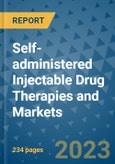For drug self-administration devices, human engineering and user ergonomics are essential attributes that impact critical patient issues such as safety and patient compliance. While designers have acquired many powerful design tools during the past decade - tools that include 3D CAD design software and high-performance materials, design team have been increasingly relying on classic end user research to define the design targets for their projects.
For specialty prefilled injection devices - a group that includes prefilled pen injectors, autoinjectors and needle-free injection devices - the ability to create product differentiation in the age of direct-to-consumer marketing and competition from generics provide incentives to consider this higher-cost option. Specialty device features such as multi-dose drug cartridges and integrated dose counters can improve ease-of-use for self-administration and create brand loyalty among consumers with chronic conditions.
What You Will Learn
- Provides detailed analysis of injectable drug products, drug delivery and device strategies, and product development factors.
- Assesses key markets, market dynamics and market demographics.
- Analyzes therapeutic demand drivers and evaluates injectable drug products in nine key therapeutic segments.
- Provides market data and forecasts.
- Profiles market sector participants, their product development activities, business strategies, and corporate alliances and affiliations
- Assesses the importance of alliances and partnerships on drug product commercialization.
- Evaluates the impact of economic, technology, and regulatory factors
Table of Contents
1. Executive Summary2. The Market Opportunity
Companies Mentioned
- Becton Dickinson
- West Pharmaceuticals
- Insulet/Amgen
- Ypsomed
- Elcam








